Adlard E.R. (ed.) Chromatography in the Petroleum Industry
Подождите немного. Документ загружается.

This Page Intentionally Left Blank
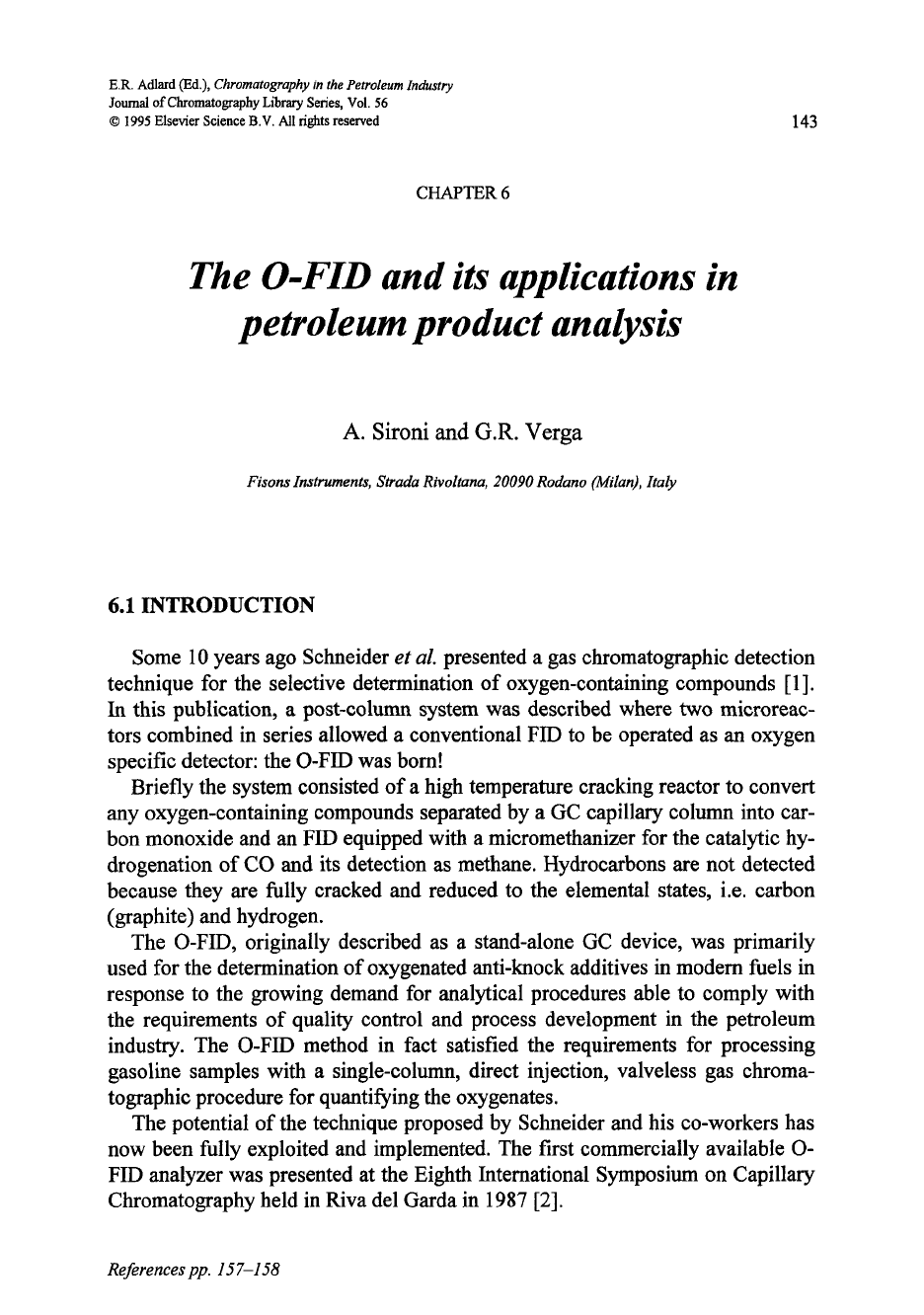
E.R.
Adlard
(Ed.),
Chromatography
in
the Petroleum Industv
Journal
of
Chromatography
Library
Series,
Vol.
56
0
1995
Elsevier Science
B.V.
All
rights
reserved
143
CHAPTER
6
The
0-FID
and its applications in
petroleum product analysis
A. Sironi
and
G.R.
Verga
Fisons
Instruments,
Strada Rivoltana,
20090
Rodano (Milan), Italy
6.1
INTRODUCTION
Some
10
years ago Schneider
et
al.
presented a gas chromatographic detection
technique for the selective determination of oxygen-containing compounds
[I].
In
this publication,
a
post-column system was described where
two
microreac-
tors combined in series allowed a conventional
FID
to be operated as an oxygen
specific detector: the
0-FID
was born!
Briefly the system consisted of a high temperature cracking reactor to convert
any oxygen-containing compounds separated by a GC capillary column into car-
bon monoxide and an
FID
equipped with a micromethanizer for the catalytic hy-
drogenation of
CO
and its detection as methane. Hydrocarbons are not detected
because they are hlly cracked and reduced to the elemental states, i.e. carbon
(graphite) and hydrogen.
The
0-FID,
originally described as a stand-alone GC device, was primarily
used for the determination of oxygenated anti-knock additives in modern fuels in
response to the growing demand for analytical procedures able to comply with
the requirements
of
quality control and process development in the petroleum
industry. The
0-FID
method in fact satisfied the requirements for processing
gasoline samples with a single-column, direct injection, valveless gas chroma-
tographic procedure for quantifling the oxygenates.
The potential of the technique proposed by Schneider and his co-workers has
now been fully exploited and implemented. The first commercially available
0-
FID
analyzer was presented at the Eighth International Symposium on Capillary
Chromatography held in Riva del Garda in
1987
[2].
References
pp.
157-158
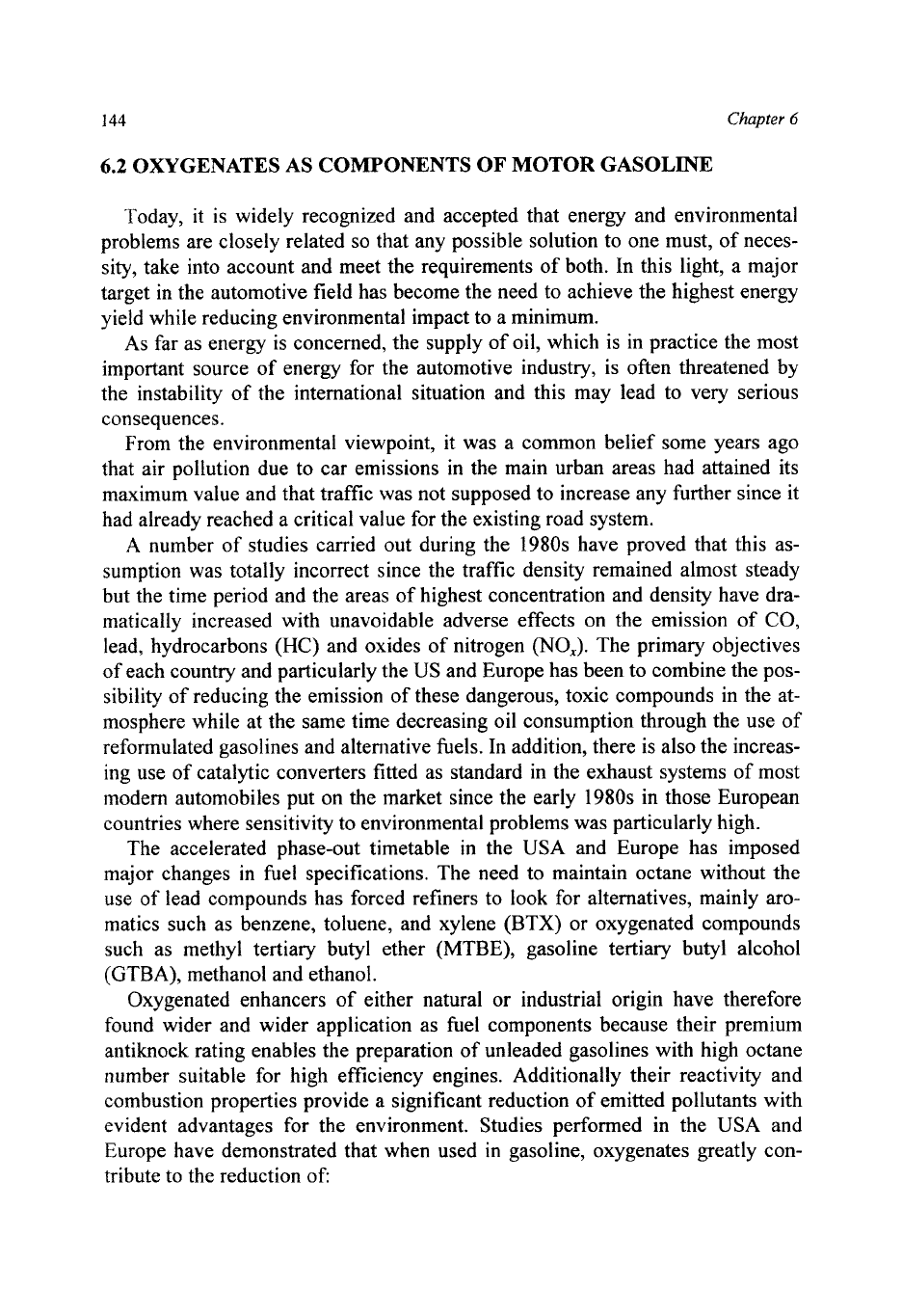
I44
Chapter
6
6.2
OXYGENATES AS COMPONENTS
OF MOTOR
GASOLINE
Today, it is widely recognized and accepted that energy and environmental
problems are closely related
so
that any possible solution to one must, of neces-
sity, take into account and meet the requirements of both. In this light, a major
target in the automotive field has become the need to achieve the highest energy
yield while reducing environmental impact to a minimum.
As
far as energy is concerned, the supply of oil, which is in practice the most
important source
of
energy for the automotive industry, is often threatened by
the instability of the international situation and this may lead to very serious
consequences.
From the environmental viewpoint, it was a common belief some years ago
that air pollution due to car emissions in the main urban areas had attained its
maximum value and that traffic was not supposed to increase any further since it
had already reached a critical value for the existing road system.
A
number of studies carried out during the
1980s
have proved that this as-
sumption was totally incorrect since the traffic density remained almost steady
but the time period and the areas of highest concentration and density have dra-
matically increased with unavoidable adverse effects on the emission of
CO,
lead, hydrocarbons
(HC)
and oxides of nitrogen
(NO,).
The primary objectives
of each country and particularly the
US
and Europe has been to combine the pos-
sibility of reducing the emission of these dangerous, toxic compounds in the at-
mosphere while at the same time decreasing oil consumption through the use of
reformulated gasolines and alternative fuels. In addition, there is also the increas-
ing use
of
catalytic converters fitted as standard in the exhaust systems of most
modern automobiles put on the market since the early
1980s
in those European
countries where sensitivity to environmental problems was particularly high.
The accelerated phase-out timetable in the USA and Europe has imposed
major changes in fuel specifications. The need to maintain octane without the
use of lead compounds has forced refiners to look for alternatives, mainly aro-
matics such as benzene, toluene, and xylene (BTX)
or
oxygenated compounds
such as methyl tertiary butyl ether (MTBE), gasoline tertiary butyl alcohol
(GTBA),
methanol and ethanol.
Oxygenated enhancers of either natural
or
industrial origin have therefore
found wider and wider application as
fuel
components because their premium
antiknock rating enables the preparation of unleaded gasolines with high octane
number suitable for high efficiency engines. Additionally their reactivity and
combustion properties provide a significant reduction
of
emitted pollutants with
evident advantages for the environment. Studies performed in the
USA
and
Europe have demonstrated that when used in gasoline, oxygenates greatly con-
tribute to the reduction
of:
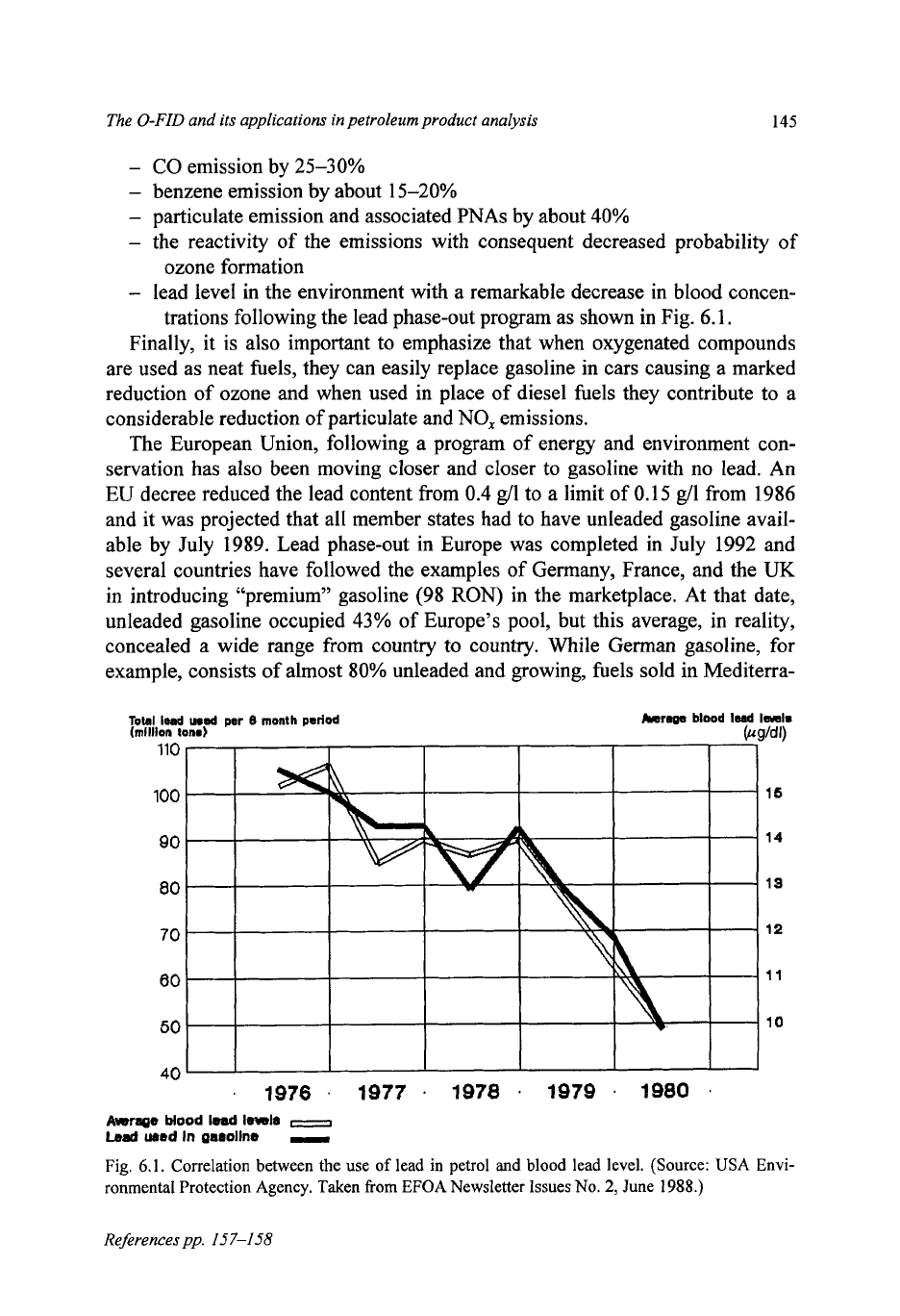
The
0-FID
and its applications
in
petroleum product analysis
145
-
CO emission by 25-30%
-
benzene emission by about 15-20%
-
particulate emission and associated PNAs by about
40%
-
the reactivity of the emissions with consequent decreased probability of
ozone formation
-
lead level in the environment with a remarkable decrease in blood concen-
trations following the lead phase-out program as shown in Fig. 6.1.
Finally, it is also important to emphasize that when oxygenated compounds
are used as neat fuels, they can easily replace gasoline in cars causing a marked
reduction of ozone and when used in place of diesel fuels they contribute to a
considerable reduction
of
particulate and NO, emissions.
The European Union, following a program
of
energy and environment con-
servation has also been moving closer and closer to gasoline with no lead. An
EU
decree reduced the lead content from 0.4 g/1 to a limit of
0.15
g/1 from 1986
and it was projected that all member states had to have unleaded gasoline avail-
able by July 1989. Lead phase-out in Europe was completed in July 1992 and
several countries have followed the examples of Germany, France, and the
UK
in introducing “premium” gasoline (98
RON)
in the marketplace. At that date,
unleaded gasoline occupied 43% of Europe’s pool, but this average, in reality,
concealed a wide range from country to country. While German gasoline, for
example, consists of almost 80% unleaded and growing, fuels sold in Mediterra-
Toul
lMd
wed
per
B
month
period
(mllllon
ton.)
110
100
90
80
70
00
50
40
11
14
1s
12
11
10
’
1976 1977
.
1978
.
1979
.
1980
Amrage
Mood
lead
Imla
-
Lead
wed
In
gaeollne
-
Fig.
6.1.
Correlation between the use
of
lead in petrol
and
blood lead level. (Source:
USA
Envi-
ronmental Protection Agency. Taken from EFOA Newsletter Issues
No.
2,
June
1988.)
References pp. 157-158
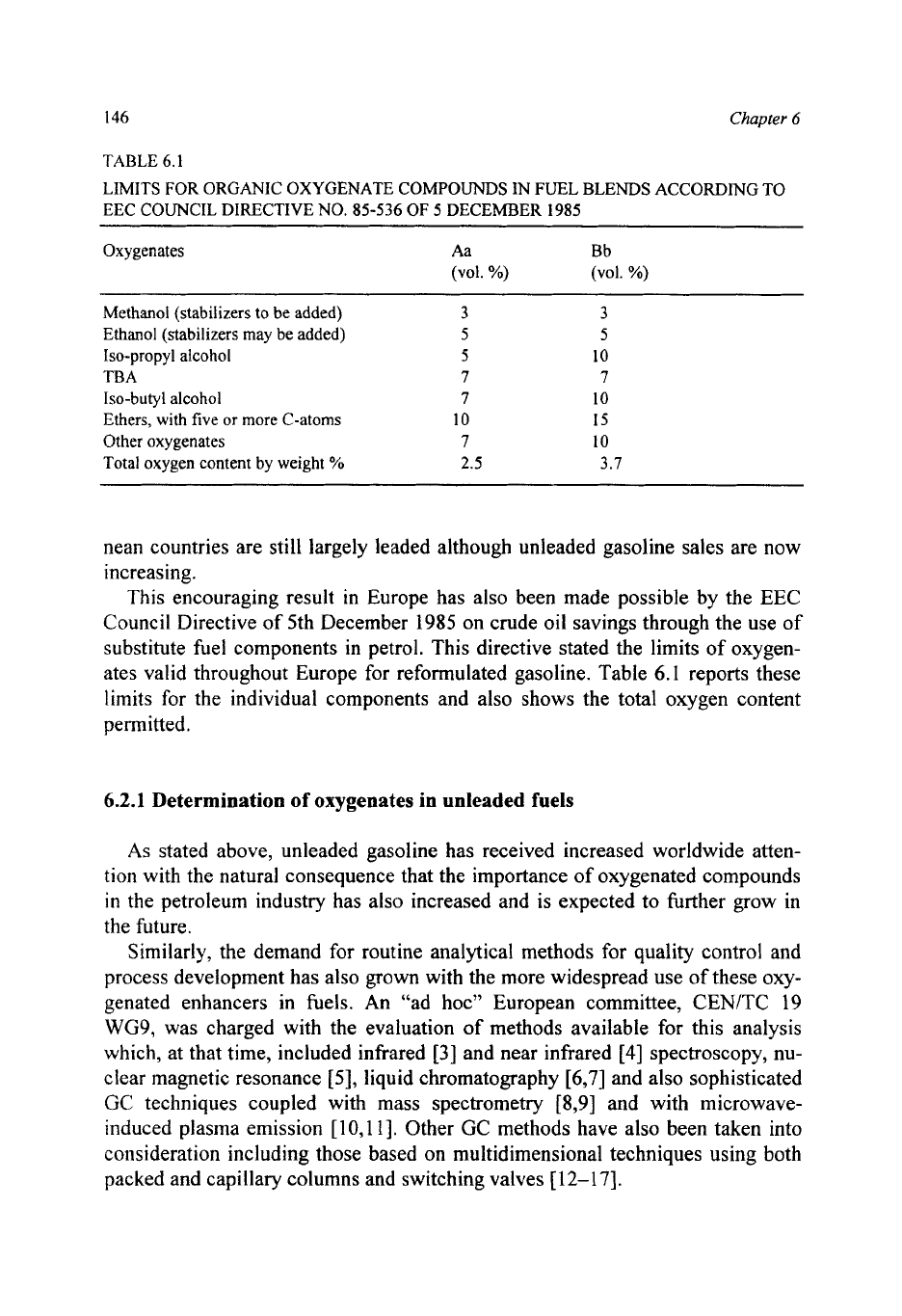
146
Chapter
6
TABLE
6.1
LIMITS
FOR
ORGANIC OXYGENATE COMPOUNDS IN FUEL BLENDS ACCORDING TO
EEC COUNCIL DIRECTIVE NO. 85-536 OF 5 DECEMBER 1985
Oxygenates
Aa Bb
(vol.
Yo)
(vol.
%)
Methanol (stabilizers to be added)
3 3
Ethanol (stabilizers may be added)
5 5
Iso-propyl alcohol
5
10
TBA
7 7
Iso-butyl alcohol
7
10
Ethers, with
five
or
more C-atoms
10
15
Other oxygenates 7
10
Total oxygen content by weight
%
2.5 3.7
nean countries are still largely leaded although unleaded gasoline sales are now
increasing.
This encouraging result in Europe has also been made possible by the EEC
Council Directive of 5th December 1985 on crude oil savings through the use of
substitute fuel components in petrol. This directive stated the limits
of
oxygen-
ates valid throughout Europe
for
reformulated gasoline. Table
6.1
reports these
limits for the individual components and also shows the total oxygen content
permitted.
6.2.1
Determination
of
oxygenates in unleaded
fuels
As
stated above, unleaded gasoline has received increased worldwide atten-
tion with the natural consequence that the importance of oxygenated compounds
in
the petroleum industry has
also
increased and is expected to further grow in
the future.
Similarly, the demand for routine analytical methods for quality control and
process development has also grown with the more widespread use of these oxy-
genated enhancers in fuels. An “ad hoc” European committee,
CEN/TC
19
WG9, was charged with the evaluation of methods available for this analysis
which, at that time, included infrared
[3]
and near infrared
[4]
spectroscopy, nu-
clear magnetic resonance
[5],
liquid chromatography
[6,7]
and also sophisticated
GC techniques coupled with mass spectrometry [8,9] and with microwave-
induced plasma emission
[
10,l
I].
Other GC methods have also been taken into
consideration including those based on multidimensional techniques using both
packed and capillary columns and switching valves [12-171.
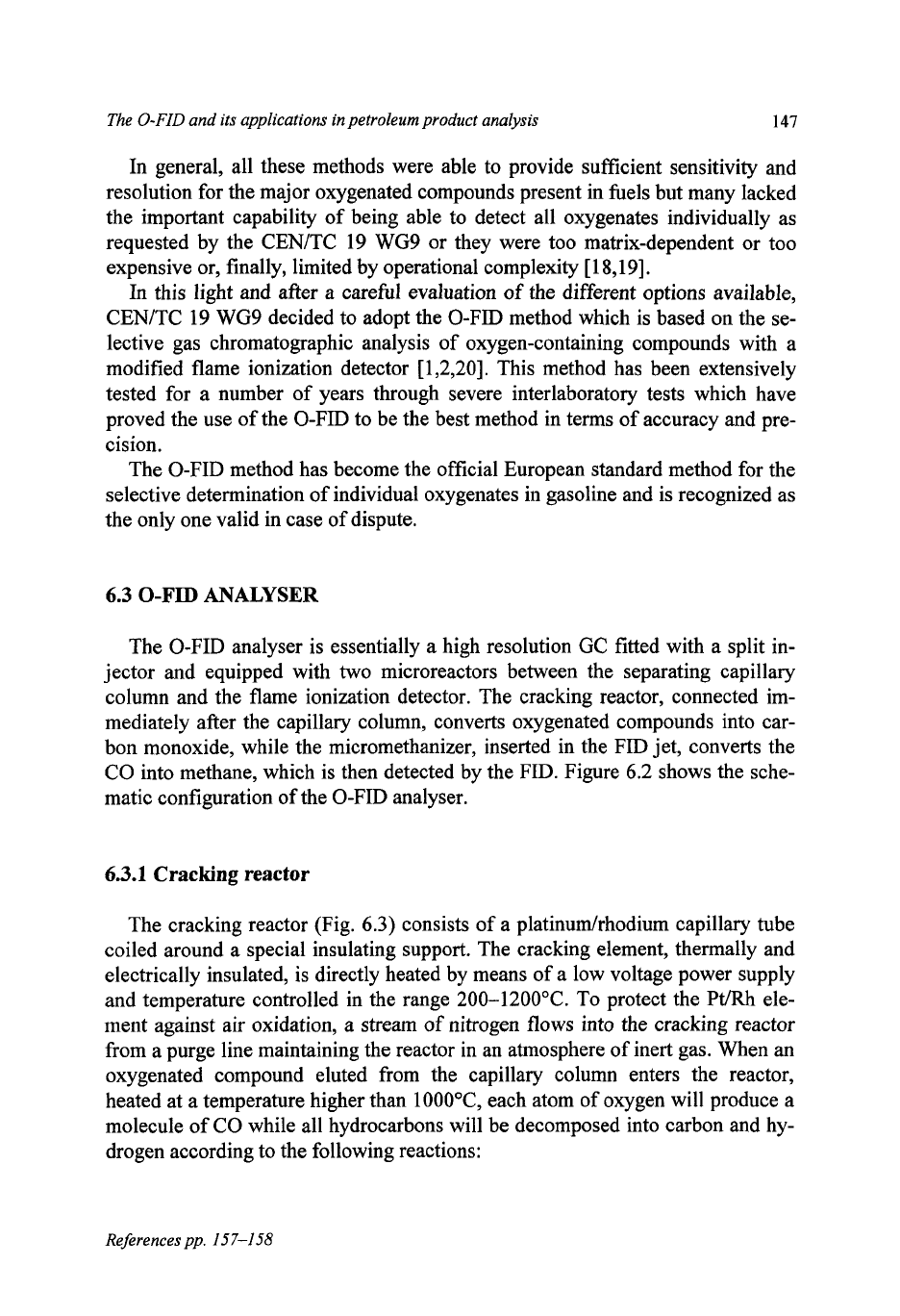
The
0-FID
and its applications in petroleum product analysis
147
In general, all these methods were able to provide sufficient sensitivity and
resolution for the major oxygenated compounds present in fuels but many lacked
the important capability of being able to detect all oxygenates individually as
requested by the CEN/TC 19 WG9 or they were too matrix-dependent or too
expensive or, finally, limited by operational complexity
[
18,191.
In this light and after a careful evaluation of the different options available,
CEN/TC 19 WG9 decided to adopt the
0-FID
method which is based on the se-
lective gas chromatographic analysis
of
oxygen-containing compounds with a
modified flame ionization detector
[
1,2,20]. This method has been extensively
tested for a number of years through severe interlaboratory tests which have
proved the use of the 0-FID to be the best method in terms
of
accuracy and pre-
cision.
The 0-FID method has become the official European standard method for the
selective determination of individual oxygenates in gasoline and
is
recognized as
the only one valid in case
of
dispute.
6.3
0-FID
ANALYSER
The 0-FID analyser is essentially a high resolution GC fitted with a split in-
jector and equipped with two microreactors between the separating capillary
column and the flame ionization detector. The cracking reactor, connected im-
mediately after the capillary column, converts oxygenated compounds into car-
bon monoxide, while the micromethanizer, inserted in the FID jet, converts the
CO
into methane, which is then detected by the FID. Figure
6.2
shows the sche-
matic configuration of the
0-FID
analyser.
6.3.1
Cracking
reactor
The cracking reactor (Fig.
6.3)
consists
of
a platinudrhodium capillary tube
coiled around a special insulating support. The cracking element, thermally and
electrically insulated, is directly heated by means of a low voltage power supply
and temperature controlled in the range 200-1200°C.
To
protect the
Pt/Rh
ele-
ment against air oxidation, a stream
of
nitrogen flows into the cracking reactor
from a purge line maintaining the reactor in an atmosphere of inert gas. When an
oxygenated compound eluted from the capillary column enters the reactor,
heated at a temperature higher than 1000°C, each atom of oxygen will produce a
molecule of CO while all hydrocarbons will be decomposed into carbon and hy-
drogen according to the following reactions:
References pp.
157-158
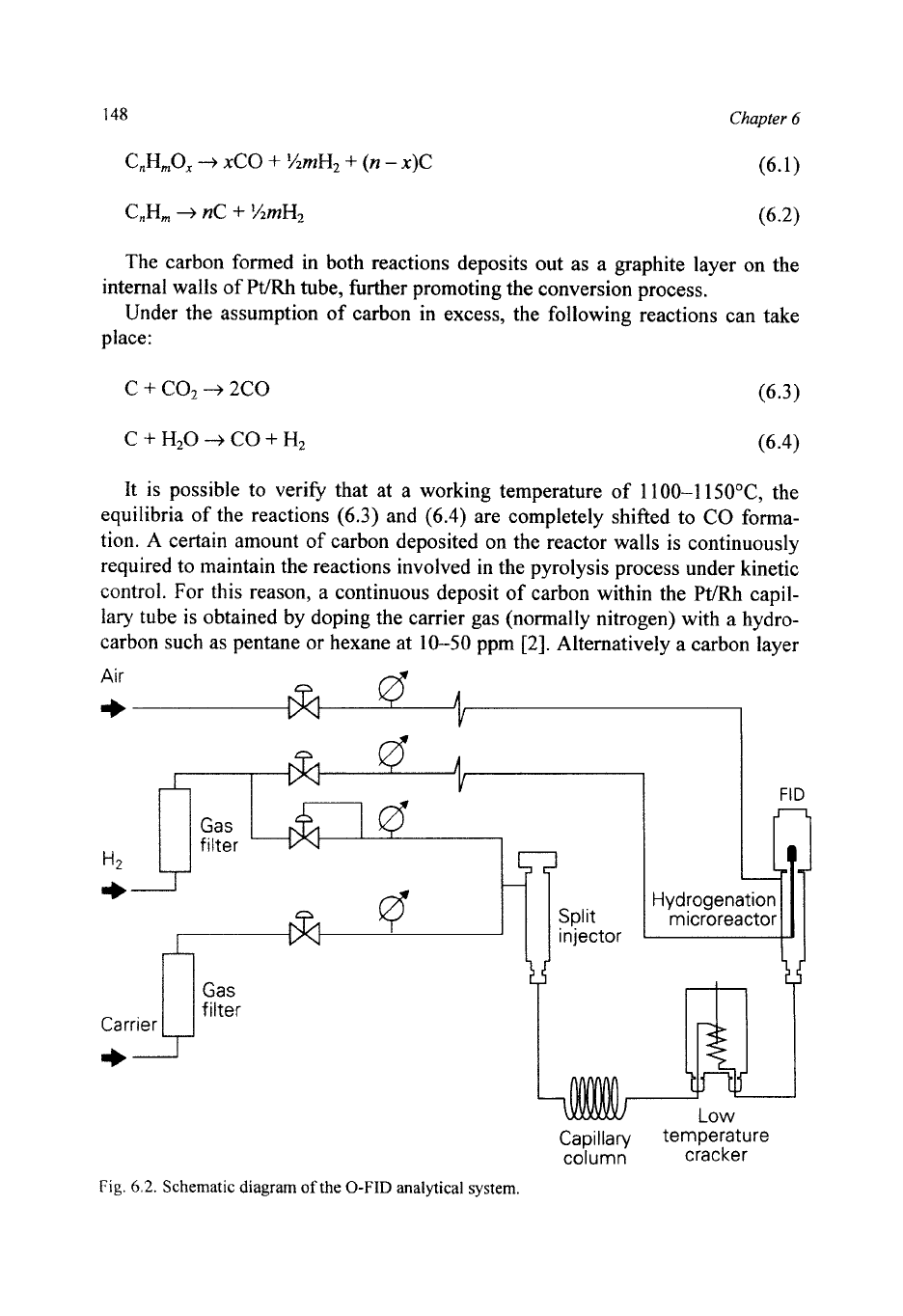
Chapter
6
148
Carrier
C,HmOx
-+
xC0
+
%mH,
+
(n
-
x)C
(6.1)
Gas
filter
The carbon formed in both reactions deposits out as a graphite layer on the
Under the assumption of carbon
in
excess, the following reactions can take
internal walls of
Pt/Rh tube, further promoting the conversion process.
place:
Carrier
c
+
coz
-+
2co
(6.3)
Gas
filter
C
+
H,O
-+
CO
+
H,
(6.4)
It
is
possible to verify that at a working temperature of
1100-1 1
50°C,
the
equilibria of the reactions
(6.3)
and
(6.4)
are completely shifted to
CO
forma-
tion.
A
certain amount of carbon deposited on the reactor walls is continuously
required to maintain the reactions involved
in
the pyrolysis process under kinetic
control. For this reason, a continuous deposit of carbon within the
Pt/Rh
capil-
lary tube is obtained by doping the carrier gas (normally nitrogen) with a hydro-
carbon such as pentane or hexane at
10-50
ppm
[2].
Alternatively a carbon layer
FID
1-
Hydrogenation
microreactor
Capillan/ temperature
column cracker
Fig.
6.2.
Schematic diagram
of
the
O-FID
analytical system.
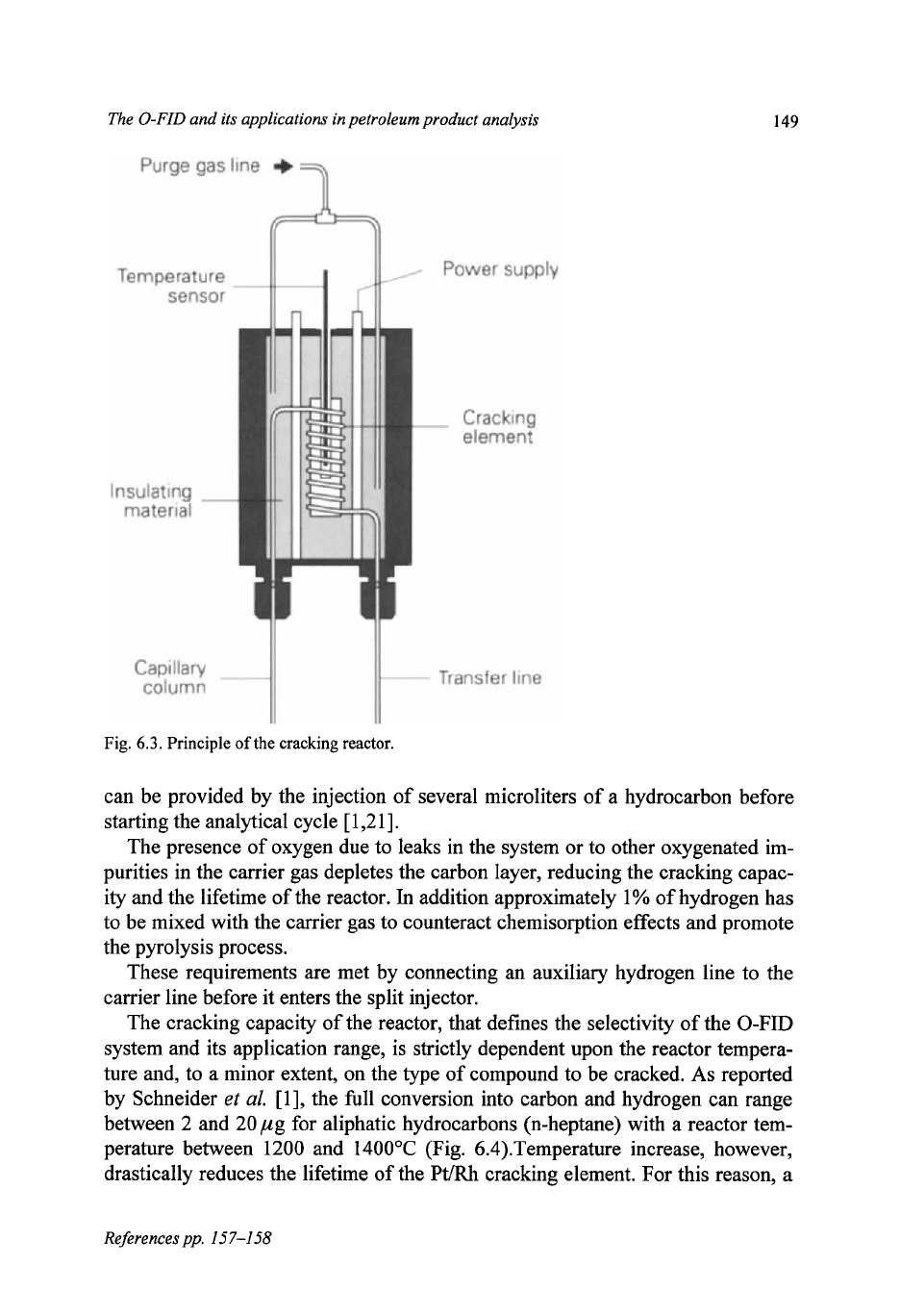
The
0-FID
and
its
applications in petroleum product analysis
149
7
Purge gas line
+
Temperature
sensor
Insulating
-
material
Power supply
-
Cracking
element
i
Capillary
column
Transfer line
t
Fig.
6.3.
Principle
of
the cracking reactor.
can be provided by the injection of several microliters
of
a hydrocarbon before
starting the analytical cycle
[
1,2
11.
The presence of oxygen due to leaks in the system or to other oxygenated im-
purities in the carrier gas depletes the carbon layer, reducing the cracking capac-
ity and the lifetime of the reactor.
In
addition approximately
1%
of hydrogen has
to be mixed with the carrier gas to counteract chemisorption effects and promote
the pyrolysis process.
These requirements are met by connecting an auxiliary hydrogen line to the
carrier line before it enters the split injector.
The cracking capacity of the reactor, that defines the selectivity of the O-FID
system and its application range, is strictly dependent upon the reactor tempera-
ture and, to a minor extent, on the type
of
compound to be cracked.
As
reported
by Schneider
et
al.
[I],
the full conversion into carbon and hydrogen can range
between 2 and 20pg for aliphatic hydrocarbons (n-heptane) with a reactor tem-
perature between 1200 and
1400°C
(Fig. 6.4).Temperature increase, however,
drastically reduces the lifetime of the
Pt/Rh
cracking element. For this reason, a
References pp.
157-158
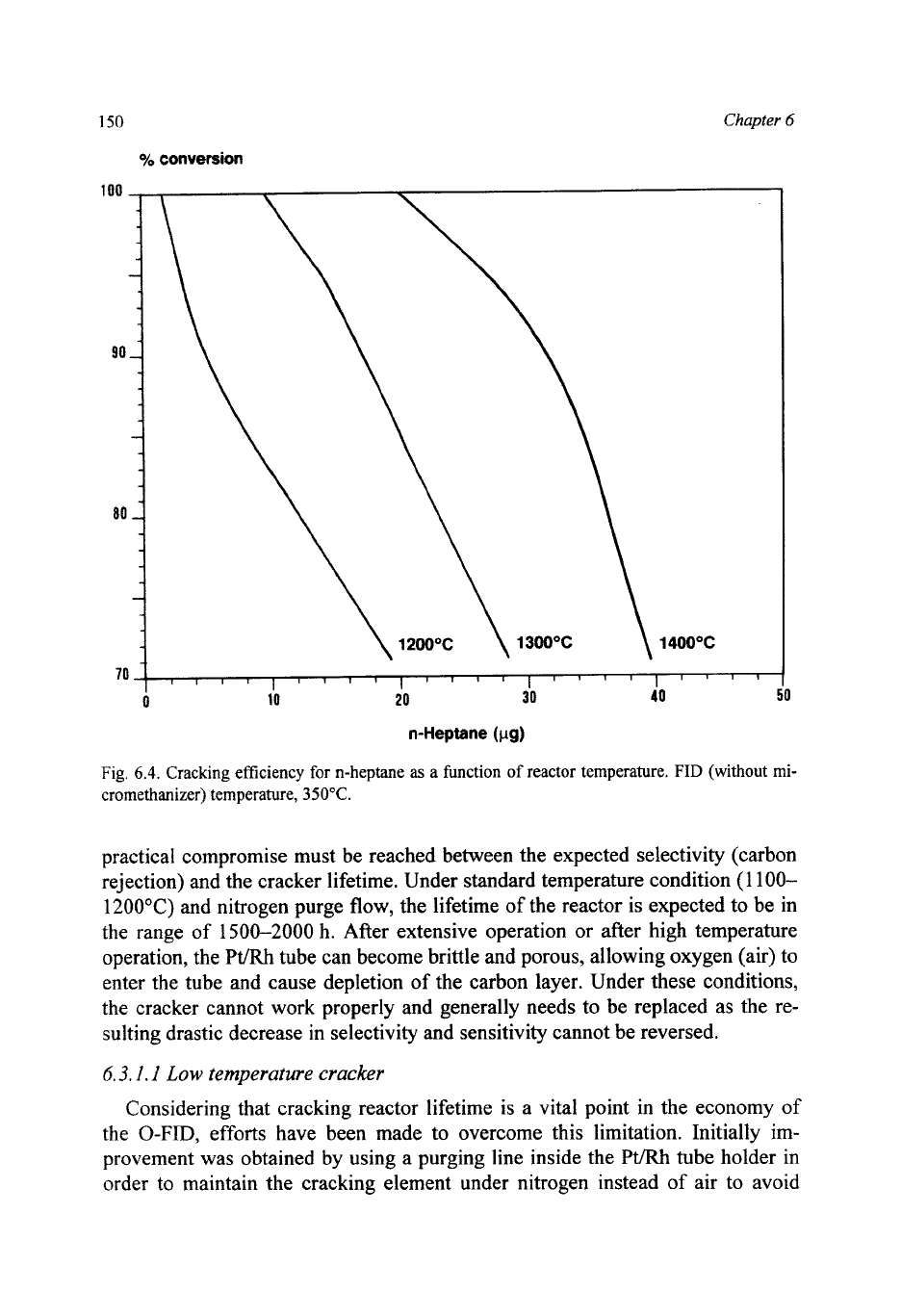
150
Chapter
6
%
conversion
-
14OOOC
70
III
I1
1III
,I
I
0
10
20
30
40
nHeptane
(pg)
I
Fig.
6.4.
Cracking efficiency
for
n-heptane
as
a hction
of
reactor temperature.
FID
(without mi-
cromethanizer) temperature,
350°C.
practical compromise must be reached between the expected selectivity (carbon
rejection) and the cracker lifetime. Under standard temperature condition
(1
100-
1200°C)
and nitrogen purge flow, the lifetime of the reactor is expected to be in
the range of
1500-2000 h. After extensive operation or after high temperature
operation, the
Pt/Rh
tube can become brittle and porous, allowing oxygen (air) to
enter the tube and cause depletion of the carbon layer. Under these conditions,
the cracker cannot work properly and generally needs to be replaced as the re-
sulting drastic decrease in selectivity and sensitivity cannot be reversed.
6.3.
I.
I
Low
temperature cracker
Considering that cracking reactor lifetime is a vital point in the economy of
the
0-FID,
efforts have been made to overcome this limitation. Initially im-
provement was obtained by using a purging line inside the
PtlRh
tube holder
in
order to maintain the cracking element under nitrogen instead of air to avoid
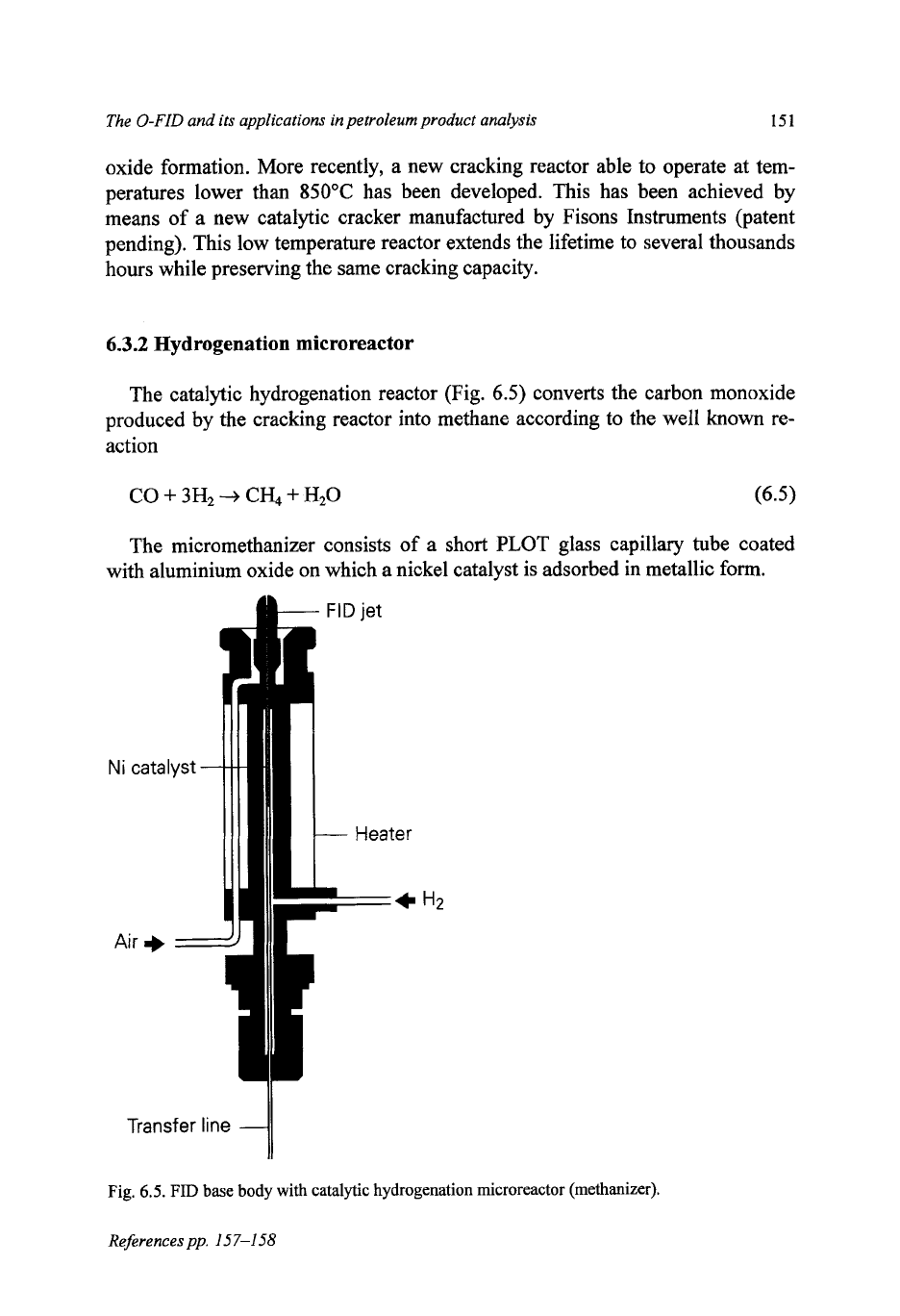
The
0-FID
and its applications in petroleum product analysis
151
oxide formation. More recently, a new cracking reactor able to operate at tem-
peratures lower than
850°C
has been developed. This has been achieved by
means of a new catalytic cracker manufactured by Fisons Instruments (patent
pending). This low temperature reactor extends the lifetime to several thousands
hours while preserving the same cracking capacity.
6.3.2
Hydrogenation microreactor
The catalytic hydrogenation reactor (Fig.
6.5)
converts the carbon monoxide
produced by the cracking reactor into methane according to the well
known
re-
action
The micromethanizer consists of a short
PLOT
glass capillary tube coated
with aluminium oxide
on
which a nickel catalyst is adsorbed in metallic form.
jet
Ni
c
Air
atalyst
+=
ieal
te
r
+
H2
Transfer
line
Fig.
6.5.
FID base body with catalytic hydrogenation microreactor (methanizer).
References pp.
157-158
